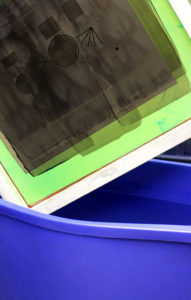
Dip tanks, the screen reclaiming method of choice in the US, are attracting more interest in Europe. But why? William Shorter, product manager of CPS, explains.
You just soak your screens in the tank of chemicals and rinse; right? With the increasing interest in this screen reclaim technique, we are being asked more and more about this process.
Dip tanks allow an all-in-one cleaner (a mixture of Aquawash and stencil remover, or a specialised stencil remover) to soften the stencil and ink at the same time, freeing you up to rinse and clean another screen whilst it is in the tank. Alternatively, you can use dip tanks separately with an Aquawash based product for the ink removal in one tank and a stencil remover for the stencil reclaim in another tank.
Before you re-fill your existing dip tank or consider purchasing your first dip tank, here are some of the common misunderstandings of this stencil reclaim process:
“Dip tanks save time and money!”
The principle behind a dip tank is to save screen printers time and money on the reclaim process. This can be true while the chemicals are fresh and new, however, over time as the chemistry strength decreases, you may need to start physically brushing the screens to get them clean. You may also use a larger volume of chemistry in comparison to the bucket and brush process as regular top ups are required to keep the chemical in a working condition. In reality you are unlikely to save time and money unless you are cleaning between 20 and 30 screens per day. You will also need to consider the costs involved in disposing of the dip tank chemicals and solids once the working solution is no longer functional.
#ScreenPrintingTopTip: Chemical consumption from top ups will be increased with dip tanks if the screens are left in the tank for too long and all the ink or stencil becomes dissolved in the solution. This build-up of ink and emulsion solids reduces the functionality of the active components in the stencil remover. Dip times should ideally be for one to three minutes, or until the stencil just starts to break away from the mesh.
“Dip tank chemistry is drain safe!”
Do not automatically assume that a product labelled as drain safe can actually be poured down your drain. What ‘drain safe’ actually means is that the product does not knowingly contain any chemicals that are banned from entering the waste water system; this is not the same as compliance. With all dip tank chemistry, you will not be able to pour the contents of your dip tank down the drain once it’s spent and you will still need to seek approval from your water authority for a consent to discharge to the drains.
It is your responsibility to find this out and to operate accordingly. Therefore, as a first step, contact your local water company who will be able to advise you on what regulations apply to your building(s) and business. We have found them to be very helpful as they also want you to get it right! The screen chemistry that you use for the bucket and brush method could potentially be the same as for dip tanks, so this advice is applicable for whichever method you choose.
“Dip tank cleaning is a two-step process!”
Typically the dip tank process is promoted and explained as a two-step process where you use an all-in-one cleaning product for the ink and stencil removal, followed by a stain remover (usually a non-caustic and low evaporating screen wash). However, the chemicals sold for the dip tank process are often not powerful enough to deliver a completely clean screen as they have been formulated for longevity in the tank. The choice of cleaning solvents for the bucket and brush method is wider and they have more powerful stain removal properties, which means that they can be optimised for the inks used.
If you are left with an emulsion or Diazo stain, whether you’ve used a dip tank or the bucket and brush method, you will still need to use a caustic based haze remover to fully clean the screen. Therefore it actually becomes a three step process, or even a four step process, if you include the degreasing element prior to coating.
Summary
Dip tanks are popular in the US, particularly at larger print shops with high screen throughput, but are they suited to your print shop?
Before making this decision you should consider the number of screens to be cleaned each day, workflow through the department, and whether dip tank products will be able to clean the inks effectively. The ability to clean the majority of screens first time, without resorting to additional haze removal steps, should be a key objective.
Take advice from your chemicals supplier and research the ‘how to’ guides available to help make the right decision.
 Printwear & Promotion The Total Promotional Package
Printwear & Promotion The Total Promotional Package




